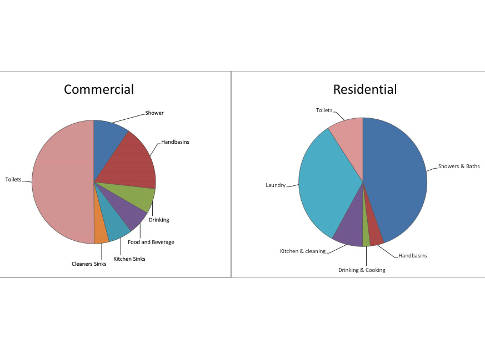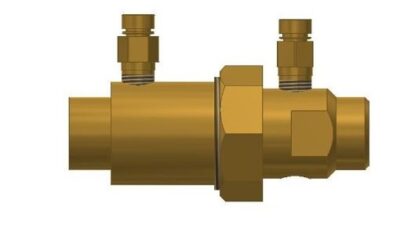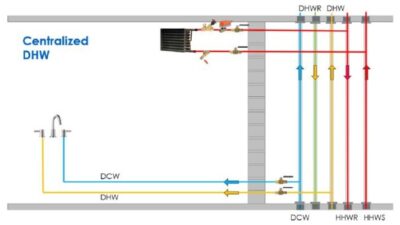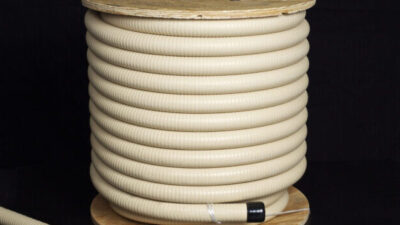Throughout the world, there is increased pressure to track and conserve water in nonresidential buildings. This article reviews the current water management options, such as using greywater and rainwater, and looks at less traditional management options, such as wastewater and condensate reuse.

Learning objectives:
- Assess the options to track and conserve water in buildings.
- Demonstrate water-reuse opportunities.
- Make use of codes and standards to design and specify water-management systems.
As the world’s population continues to grow and our cities and suburbs expand, with more buildings to accommodate the growth, we are facing a major challenge to manage and protect our valuable water resources. This is becoming especially critical under the added pressure of climate change.
The conventional and common approach to water management involves supplying potable water and disposing of wastewater and stormwater. The latter may be disposed of onsite. It is becoming increasingly apparent that this conventional, centralized approach must change in response to urbanization trends and climate predictions. As the availability of clean freshwater resources is diminished, it is becoming clear that wastewater and stormwater should be viewed as alternative and valuable sources of water, and not just inconveniences needing to be dealt with. Consequently, rainwater collection and reuse and the reuse of highly treated wastewater effluent are attracting increased attention. They are most-commonly provided for nonpotable end uses; potable reuse is also gaining traction.
Many communities have begun to implement simple and relatively inexpensive water-reuse projects, such as irrigating golf courses and parks, and the benefits of these are seen almost immediately. Benefits from widespread adoption include improved reliability and drought resistance of the water supply, utility savings in infrastructure maintenance and deferred capital expenses, and the immediate rewards of green and lush outdoor recreation spaces.
There are also environmental advantages to consider. The use of reclaimed water ensures the transfer of nutrients to beneficial uses rather than discharging them into receiving waterways. Contamination of bays and lakes with nutrient-rich stormwater and wastewater increases the risk of eutrophication (excessively high nutrient concentrations), the consequences of which include low dissolved oxygen concentrations, algal blooms, and declining shellfish populations and periodic fish kills.
Increased and more widespread use of reclaimed water typically brings with it greater financial, technical, and institutional challenges. Upfront capital costs may be higher, but payback on these water-reclamation systems may be realized sooner by building owners, depending on the region. Regulators and citizens express concerns about the safety of using reclaimed water for domestic purposes because of the perceived risks and uncertainties. These challenges have limited the application of water reuse in the past. However, 21st-century technology exists to safely produce recycled and desalinated water at a relatively low cost, which is highly dependent on geographic location and local water resources. Combined with the increased need to do so, we should now be striving for new paradigms in water supply and management.
Water efficiency, conservation
Significant reductions in water use can be made by insisting that water-efficient fixtures meet building code, instead of installing older-style high-flow units. These include water-efficient dual-flush toilets, low-flow showerheads, low-flush urinals, flushless urinals, low-flow faucets, and flow restrictors.
External landscaping with minimal water requirements also promotes water savings. Landscaping can be designed with the use of drought-tolerant species, garden mulch techniques that minimize water losses, and subsurface irrigation methods including automated irrigation systems with rain and moisture sensors to ensure optimum application of irrigation water.
To understand where water savings can be made, a detailed water-balance model of the project should be carried out during the design phase. This process will identify all possible water savings by incorporating uncomplicated water-efficiency strategies into the development design. Using this approach, we have found that the use of water-efficient fixtures and water-conservation design strategies can reduce an average retail or commercial development’s overall water use by more than 40%, when compared with U.S. Green Building Council LEED v4 baseline flows.
Identifying water-reuse opportunities
Opportunities associated with the design and installation of water-reuse systems will vary significantly from one building project to the next. Analysis of the water-balance model at the outset of the project will reveal any opportunities for alternate water supply, water conservation, and water recycling. Water-balance modeling will also reveal the availability of rainwater and wastewater that could be captured and treated for reuse.
All aspects of building operations that involve water should be investigated and potential sources of water identified. For instance, condensate recovery from a cooling system can be an excellent ongoing source of relatively high-quality reuse water. Also, both internal and external water sources should be considered.
Treatment infrastructure, which often includes filtration and disinfection, will be required to ensure water is of a suitable quality for its intended use. Relatively clean water sources, such as roofwater, are relatively straightforward to collect and are suitable for nonpotable use with little pretreatment. More highly contaminated wastewater streams, such as blackwater, require a higher degree of treatment to make them fit for use. This process will be more energy-intensive. Blackwater and greywater recycling methods usually have greater infrastructure and treatment costs than rainwater collection and reuse, but they also have the added advantage of year-round water-source availability—so they are not reliant on seasonal rainfall patterns and climate.
Supplying reclaimed water to nonpotable applications where the risk of human contact is very low can be an excellent way of offsetting the consumption of potable-water sources. For example, with cooling tower water, the level of direct human contact is minimal. However, to reduce the risk of illness caused by airborne and waterborne pathogens, the level of disinfection prior to reuse should be in line with the risks involved. Nonpotable demands include toilet and urinal flushing, irrigation, and cooling towers. Potable demands include water for kitchen use, showers, and sinks It is important to understand the relative proportions of potable and nonpotable demand, and this can be achieved through the water-balancing process.
In office complexes, the amount of water used for toilet and urinal flushing is proportionally higher than the amount used in showers. In apartment buildings, the opposite is true—water used for bathing and showering exceeds the toilet-flushing demand (see Figure 1).
Buildings and complexes with water-cooled boilers or cooling towers for air conditioning require large volumes of water to feed these systems. Properties with large gardens and lawns tend to use a significant portion of their water budgets for outdoor irrigation.
The current level of public acceptance and regulations in some areas mean little opportunity for the use of harvested or recycled water for potable use. To ensure water reuse is an option, the engineer must manage potential public health, operational, and environmental risks associated with the specific application. The primary risks associated with the use of reclaimed water are:
- Public health, which refers to inadvertent contact with the water and subsequent ingestion of pathogens and toxins, particularly relevant in the health and immunocompromised sectors.
- Environmental, which refers to the accumulation of contaminants in irrigated soils and plants or detrimental hydrological effects as a result of water extraction.
- Availability, which is dependent on rainfall patterns and catchment activities, sizing of treatment plants and buffer tanks, and maintenance schedules and equipment downtime.
- Operational, such as potential clogging and fouling of distribution systems and mechanical equipment with suspended and precipitated solids, and staining of toilet bowls.
Given the different treatment requirements of the various rainwater and wastewater sources and the potentially different end-use water qualities required, a detailed water-balance and feasibility assessment should be undertaken in all system designs.
Water balance and feasibility
A water balance is used to quantify both the reuse demands and the potential reuse supplies, as well as the timing of those supplies, to marry the two in the most economic and practical way.
Areal rates (water use per area) established throughout the industry for various building types and climatic regions are commonly used to establish water usage in a building. Unfortunately, these rates often do not take into account the "real" use of the buildings, which can drastically impact the actual water demands. The majority of water use in a building is actually dependent on population and occupancy profile, rather than the area of the building. About half the building’s water use is associated with heating and cooling, which also is highly dependent on population, as a large portion of heat rejection is due to heat generated from computer terminals.
A far more practical approach is to consider the actual population and how the proposed building will be used, and design accordingly. First, it is necessary to establish the occupancy for a building: Occupancy represents the population, how that population varies with time, and how that population uses water in the building. Does the building population change throughout the day or year? Do the workers spend most of their day in the building? How do they use water in the building? Is the building in operation 7 days a week or only during weekdays? Does the building receive many visitors? How long do the visitors stay, and are they likely to use the restrooms? There may be a number of different population profiles for the one building, and each one should be modeled.
The timing of that water production and water usage is also important. For example, while the annual volume of rainfall falling on a site often can meet a specific reuse demand, in temperate climates the mismatch between the timing of the rainfall—which occurs mostly in winter—and irrigation or cooling tower demands-which are highest in summer—can lead to unfeasibly large tank storages and long storage times that encourage microbial growth to optimize the reuse volume. Similar pitfalls apply to working with monthly data; it is critical to model the water balance using daily data.
Once the populations and building uses are established, they can be used to generate daily water-use patterns through knowledge of fixtures and fittings in the building and corresponding flow rates. For each population set, the number of urinal or toilet flushes, sink uses and duration, shower uses and duration, and consumption can be calculated. Other uses—including irrigation, mechanical plant operation (i.e., cooling towers, chillers, and boilers), cleaning, kitchen, washdown, and laundry—are also included as appropriate. Knowledge of the water use in all these areas allows an analysis of both the greatest demands for reused water and where the greatest water savings can be made.
Identification and analysis of available source water for the reuse supply is then undertaken. The volumes of greywater and blackwater available for treatment and reuse are derived directly from the water balance. Rainwater, roofwater, and stormwater are modeled based on daily historical data, catchment area, tanks size, and identified reuse demand. The optimum tank sizing is approached in an iterative manner by varying tank size and analyzing the reuse potential (reuse volume and percentage of days that source water is available when required).
Groundwater is modeled based on predicted extraction flows from an appropriate hydrogeological study. Consideration should also be given to water sources external to the site, such as a large roof catchment on an adjacent site. While this can complicate the situation from a regulatory point of view, opportunities may exist that provide some synergies.
Overall water-management strategy
An overall strategy is then developed based on matching quantities of demands and potential reuse supplies. The strategy generally incorporates an integrated approach for deploying water-use reduction along with various reuse schemes. Engineers should search for innovative synergies and double or triple the use of space, resources, or functions—for example, using a landscaped area for a water treatment zone.
In all cases, an economic evaluation of the proposed solution would be performed to ensure appropriate strategies are being implemented. While often the true value of water (the value when no water is available) is not considered, the economic evaluation will enable the more cost-effective sources of reuse water to be identified and implemented.
Codes and standards
Water-management and -reuse strategies are subject to local, state, and federal laws as well as codes and standards, and should be developed in consultation with all relevant stakeholders. Cross-connecting reuse water supplies with potable supplies is a major risk unless relevant standards and codes are followed.
It should be noted that in the United States, regulations with regard to water reclamation and reuse vary from state to state. The relevant state departments for environment, water quality, and public health should also be consulted with regard to applicable regulations.
The Uniform Plumbing Code, produced by the International Association of Plumbing and Mechanical Officials, and the International Plumbing Code, produced by the International Code Council, are the two main plumbing codes in use within the United States. The American Society of Plumbing Engineers (ASPE) also assists ANSI in the development of relevant standards in relation to water reuse.
Other organizations including the American Water Works Association, WateReuse Association, Water Quality Association, and NSF International also provide a range of manuals, guidelines, and product certifications in relation to water reclamation and reuse.
Related standards include:
- American Rainwater Catchment Systems Association (ARCSA)/ASPE/ANSI 63-2013: Rainwater Catchment Systems
- ARCSA/ASPE/ANSI 78: Stormwater Harvesting System Design for Direct End-Use Applications
- NSF/ANSI 350: Onsite Water Reuse
- NSF/ANSI 350-1: Onsite Residential and Commercial Greywater Treatment Systems
Peter Harbour is a senior scientist at CJ Arms and Associates.
Robyn Overall is water sustainability scientist at CJ Arms and Associates.



